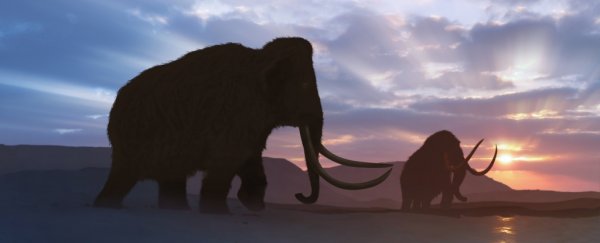Four thousand years ago, the last woolly mammoths quietly died on their final bastion - the isolated Wrangel Island, north of Russia in the frozen Arctic. Their demise was sudden, and strange; now, new evidence points to the mammoths themselves as partial agents of their own demise.
Specifically, the mammoths (Mammuthus primigenius) were afflicted by genetic diseases, likely brought about by a lack of genetic diversity. As their numbers declined and the pool of available mates grew ever smaller, detrimental genetic mutations increased, resulting in an increasingly unhealthy herd.
The evidence is compelling, as it's not just genome sequencing. Scientists actually raised the mammoths' genes from the dead, and placed them in elephant embryo cells in the lab to see how well they functioned.
The answer is: Not well at all. The genes were sad, stumbling, broken things that could have seriously impaired important functions, such as male fertility, and the mammoths' sense of smell.
"The key innovation of our paper is that we actually resurrect Wrangel Island mammoth genes to test whether their mutations actually were damaging (most mutations don't actually do anything)," said evolutionary biologist Vincent Lynch of the University at Buffalo.
"Beyond suggesting that the last mammoths were probably an unhealthy population, it's a cautionary tale for living species threatened with extinction: If their populations stay small, they too may accumulate deleterious mutations that can contribute to their extinction."
The death of the mammoth on Wrangel Island has been the subject of a number of studies. Last year, isotope analysis of the bones and teeth of the animals - which can reveal what the deceased ate over the course of their life - pieced together dramatic changes in the mammoths' diet that point to dramatic environmental changes.
Prior to that research, scientists had conducted complete genome sequencing on Wrangel Island woolly mammoths along with earlier, more healthy mammoth populations. The results were published in 2017; in those genomes, the scientists found "accumulation of detrimental mutations … consistent with genomic meltdown."
The new research builds on that 2017 paper. "The results are very complementary," Lynch said.
"The 2017 study predicts that Wrangel Island mammoths were accumulating damaging mutations. We found something similar and tested those predictions by resurrecting mutated genes in the lab."
Lynch and his colleagues identified detrimental mutations by comparing the genome of the Wrangel Island mammoths to their living relatives - three Asian elephants (Elephas maximus).
They also compared it to the genomes of two other mammoths - one from 44,800 years ago, and the other from 20,000 years ago, when the populations were large and hale.
From these comparisons, they were able to identify mutations related to defects in sperm morphology; neurological development; insulin signaling; and olfactory receptors.
Then, they raised these mutated genes from the dead. They synthesised and cloned the genes, then placed them in gene-edited elephant embryos in a petri dish, so the researchers could observe how proteins expressed by the genes interacted with other genes and molecules.
"We know how the genes responsible for our ability to detect scents work," Lynch explained.
"So we can resurrect the mammoth version, make cells in culture produce the mammoth gene, and then test whether the protein functions normally in cells. If it doesn't - and it didn't - we can infer that it probably means that Wrangel Island mammoths were unable to smell the flowers that they ate."
The animals also likely had higher rates of male infertility, and diabetes, as well as neurological defects. But it's also important to note that this would not have been the only factor contributing to the end of the woolly mammoth.
Their demise began 11,700 years ago, towards the tail end of the last ice age. As the world warmed, and humans (and their hunting) spread, mammoths petered out; by just under 10,000 years ago, the species was extinct from its extensive mainland habitat across Eurasia and North America.
This drastic decline of numbers decreased genetic diversity, which meant that the animals were inbreeding to a higher degree, and less capable of purging bad mutations. We've seen this phenomenon multiple times just prior to a species' extinction, and understanding it is an important tool for conservation.
It's way too late, of course, for the mammoth. But the multiple factors leading up to its lonely end could teach us to do better by the animals still living on our planet.
The research has been published in Genome Biology and Evolution.
